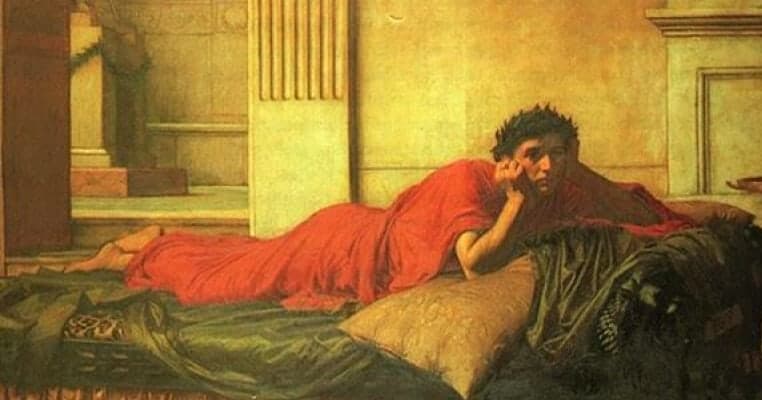On June 9th, 68 AD, Tiberius Claudius Nero Caesar— better known as Emperor Nero — died by his own hand after being declared an enemy of the state by the Roman senate. It was an ignominious death for the last of the original imperial dynasty, the Julio-Claudians. Deserted and reviled, Nero had fled Rome in disguise to the villa of one of his freedmen. Once there, the man who had killed his wife, mother and adopted brother without compunction and was rumored to have started the Great Fire of Rome spent the last few hours of his life attempting to avoid the inevitability of his death.
Nero was so terrified of dying that he begged one of his servants to kill themselves to serve as an example to him- before a troop of armed soldiers forced his hand. Even then he needed help to drive the dagger home. However, within months of his death, rumors began that Nero still lived and would return in glory to reclaim his empire. Over the next twenty years, as many as three “false Neros” came forward claiming to be the notorious emperor and seize the imperial purple. All were out-ed as fakes and foreign pawns. But why did so many cling to the idea that the former emperor lived? And why would anyone believe that someone impersonating someone as reviled as Nero could help them seize power in Rome?

The Life and Reign of Nero
Lucius Domitius Ahenobarus was born at Antium on December 15, 37 AD, the son of Gnaeus Ahenobarus and Agrippina the younger — the daughter of Germanicus and Agrippina, the granddaughter of Emperor Augustus. By 48 AD, Agrippina the Younger had married her Uncle, Emperor Claudius and in 50 AD, the ailing Emperor adopted his great-nephew as his son. Lucius Domitius now became Tiberius Claudius Nero Caesar. Just three years later, after the death of Claudius, he became Emperor Nero, after superseding Claudius’s natural son, Britannicus.
The first five years of Nero’s reign were relatively benign. The young emperor seemed intent on becoming a second Augustus and made a great speech to the Senate acknowledging their authority — minting coinage bearing the stamp of senatorial authority to reinforce his words. Nero also deified his predecessor Claudius and made a show of merciful rule by avoiding the death penalty as much as possible. However, behind the scenes, the cracks were beginning to show, and Nero started to remove anyone in perceived opposition to him. In 55 BC he murdered his adopted brother Britannicus after growing tensions with Agrippina led her to shift her attention to the young Prince. Agrippina followed in 59BC, and finally, in 62 AD, Nero murdered his first wife Octavia and her elder sister.
Then in 64 AD, the Great Fire of Rome broke out. The conflagration lasted for nine days and wiped out much of the city. Nero provided emergency help and shelter for the dispossessed — but he also appropriated vast swathes of public land which he turned into a lavish palace and gardens — the so-called Golden House of Nero. These advantages to Nero led to rumors that the Emperor was the arsonist. So Nero responded by looking for other scapegoats to satisfy the mob in the form of Rome’s Christian population who he cruelly persecuted.

Nero’s reputation amongst the elite began to plummet — although he remained popular with the people. The disastrous Boudiccan Revolt and war with Parthia did little to bolster the emperor’s reputation. Nor did the Emperor’s excesses. In 65Ad, a plot to replace Nero arose which he learned of and thwarted. However, the foiled coup only made Nero worse and widespread executions followed, including the poet Lucan and the emperor’s old tutor, Seneca. Nero even turned on his old friend Petronius, author of the Satyricon. His murderous madness finally culminated in him kicking his pregnant wife, Poppaea, to death.
In the aftermath, Nero abandoned Rome and spent a happy two years touring Greece, competing in athletic and musical contests — including the Olympic games — and basking in the adoration of his Hellenistic subjects. However, in January 68AD, the emperor’s extended foreign holiday came to an abrupt close when Helios, the freedmen he had left governing Rome, advised Nero to return to Rome quickly — or lose the purple. Nero complied — but it was too late. A famine in the city, caused by Nero cutting grain supplies had lost him the support of the populace, but worse still, Nero had lost the support of the army. They now supported a new imperial candidate, the governor of Spain, Galba. By early June 68 AD, Nero’s end was in sight. The Senate declared him a public enemy on June 9th, 68 AD. However, by the time they made the declaration, the Emperor had fled Rome.

